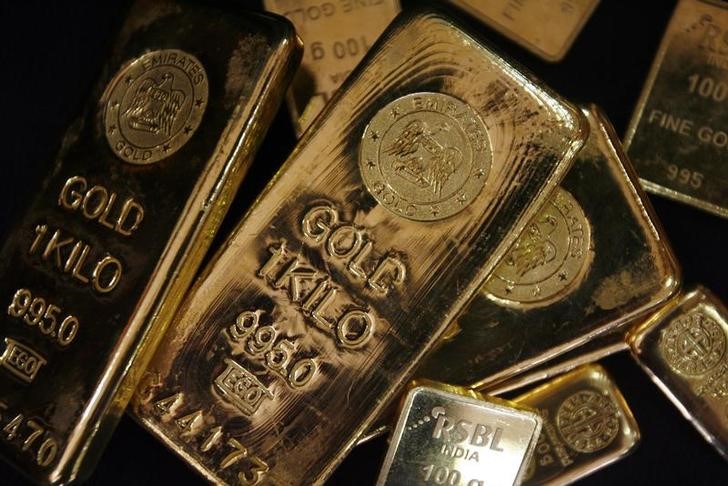Commodities
Gold prices skittish before GDP data; copper upbeat on China stimulus


© Reuters.
Investing.com– Gold prices nursed steep losses on Thursday as anticipation of a barrage of U.S. economic and interest rate cues kept traders averse to the yellow metal, while copper sat on strong gains this week following more stimulus measures from China.
Bullion prices had fallen 0.7% on Wednesday, largely disregarding some weakness in the as anticipation of key U.S. gross domestic product (GDP) and inflation data brewed more uncertainty over interest rates.
The yellow metal was battered by increasing bets that the Federal Reserve will cut interest rates later, instead of earlier this year. A series of record-high finishes on Wall Street also dented demand for gold, as traders shifted towards more risk-heavy, high-yielding assets.
But despite the losses, gold prices stuck largely to a $2,000 to $2,050 an ounce trading range established over the past week, as worsening geopolitical conditions in the Middle East spurred some safe-haven demand.
rose 0.1% to $2,015.36 an ounce, while expiring in February steadied at $2,015.20 an ounce by 00:38 ET (05:38 GMT). Futures prices falling below the spot rate indicated that traders expected a near-term decline in gold prices.
US GDP, inflation data in focus before Fed meeting
Market focus turned squarely towards key data due later on Thursday, which is expected to show some cooling in growth. But the U.S. economy is also expected to remain well ahead of its peers in the developed world.
data- the Fed’s preferred inflation gauge- is due on Friday, and is likely to show inflation remained sticky in December. Resilience in the U.S. economy and sticky inflation give the Fed more headroom to keep rates higher for longer- a warning that was voiced by several Fed officials earlier in January.
Their warnings, coupled with strong inflation and labor market readings, saw traders steadily unwind bets that the Fed could begin cutting rates by as soon as March 2024. This trend saw gold prices mark a weak start to 2024.
High rates increase the opportunity cost of buying bullion and diminish the yellow metal’s appeal. While gold is expected to eventually benefit from U.S. rate cuts this year, the potential timing of the cuts remains uncertain.
Copper at 3-week high as China doles out more stimulus
Among industrial metals, expiring in March fell 0.2% to $3.8678 a pound, but remained close to a three-week high hit on Wednesday.
Sentiment towards the red metal was boosted by China’s central bank unexpectedly cutting its for local banks, which is expected to release nearly $140 billion of liquidity into the economy.
The People’s Bank also loosened lending requirements for the commodity-heavy property sector, and said it had more measures in the pipeline to foster a Chinese economic recovery.
The moves helped ease concerns over weakening demand in the world’s largest copper importer- which were a key weight on prices of the red metal over the past year.
But the demand outlook for copper remained uncertain, especially in the face of a potential downturn in the electric vehicle market. EV maker Tesla Inc (NASDAQ:) clocked weaker-than-expected fourth-quarter earnings and flagged weaker sales growth in 2024.
Upgrade your investing with our groundbreaking, AI-powered InvestingPro+ stock picks. Use coupon INVPRO2024 to avail a limited time discount on our Pro and Pro+ subscription plans. Click here to know more, and don’t forget to use the discount code when checking out!
Commodities
Oil prices rise; U.S. crude inventories plunge, Russia-Ukraine truce eyed
Commodities
India’s Reliance to stop buying Venezuelan oil over US tariffs, sources say
Commodities
Oil prices climb on Venezuela supply worries

 Forex3 years ago
Forex3 years agoForex Today: the dollar is gaining strength amid gloomy sentiment at the start of the Fed’s week

 Forex3 years ago
Forex3 years agoUnbiased review of Pocket Option broker

 Forex3 years ago
Forex3 years agoDollar to pound sterling exchange rate today: Pound plummeted to its lowest since 1985

 Forex3 years ago
Forex3 years agoHow is the Australian dollar doing today?

 Cryptocurrency3 years ago
Cryptocurrency3 years agoWhat happened in the crypto market – current events today

 World3 years ago
World3 years agoWhy are modern video games an art form?

 Commodities3 years ago
Commodities3 years agoCopper continues to fall in price on expectations of lower demand in China

 Economy3 years ago
Economy3 years agoCrude oil tankers double in price due to EU anti-Russian sanctions























